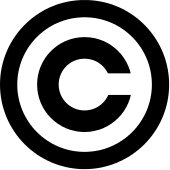Assignment
Complete in Order:
1. Complete, Print, and Submit
2. Watch Copyright Video below
3. In a group of two, complete the two worksheets, Print, and Submit
4. Complete, Print, and Submit
5. Complete, Print, and Submit
6. Watch Copyright and Fair Use Video
7. Complete, Print, and Submit
8. Watch Creative Commons Kiwi Video
9. Read, Complete, Submit
10. Review for Test
Copyright
Principles and Rules of Copyright
Copyright is protection for intellectual property.
Intellectual property consists of anything an individual has written or created. It might be music, text, pictures, photographs, sounds, and so on.
Fair use doctrine is part of the copyright laws. It states that limited portions of material may be used without written permission for certain purposes, such as reporting the news or schoolwork. It doesn’t define “limited,” though, so be sure you don’t overuse material. The fair use doctrine requires you to give credit to the author or creator of any material you use.
Derivative works are copyrighted materials that have been altered or changed. Such material is protected by copyright laws. If you alter a copyrighted photograph by using computer software, that photograph is still protected, and you may not use it without written permission.
Academic standards for copyrighted material are higher than others. Because scholars and researchers study so many different ideas and are responsible for sharing those ideas with the world, they are required to satisfy higher standards of honesty. They must give credit not only when quoting someone else’s exact words but also for the ideas those words represent. As a researcher, you cannot paraphrase what someone else says and not give credit for it.
Bibliographies are lists of sources that have been used in research. When using the Internet for research or for design work, you need to give credit where it is due. Often, people who use graphics and images from the Internet for publication on their own web page create a list of image credits rather than a bibliography.
Rules of Copyright
1. You cannot use copyrighted material without written permission from the creator of the material (or from its copyright holder).
2. Material can be protected even if it does not display the © symbol. Even if no mention is made regarding copyright, you must assume that all material from another source is protected.
3. Penalties for violating copyright laws can range from mild to severe. If you break the copyright law, you might simply receive an e-mail message from the author asking you to stop using the material. If you publish the material on a website, the webmaster might shut down your site. Or you could be sued by the author or prosecuted by federal authorities.
4. To make sure you are not violating any copyright law, it is important that you do the following:
- Write or send e-mail to the author or creator and ask permission to use the material. Do not use it until you are given permission.
- Follow the directions on the site regarding use of material. You might be asked to create a link on your page or to notify the author or creator.
- Most important: Do not use any material if you don’t have written permission.
5. To copyright your own material, the copyright notice for visually perceptible material must contain one or more of the following elements:
- The symbol © (the letter C in a circle), or the word “Copyright,” or the abbreviation “Copr.”; and
- The year of first publication
- The name of the owner of copyright
- Example: © 2010 Adobe Systems Incorporated
- Phonorecords and sound recordings use the letter P in a circle, and
- The copyright notice should be affixed in such a way as to “give reasonable notice of the claim of copyright.”
For more information on copyrights, visit the United States Copyright Office on the web at
http://www.copyright.gov/.
